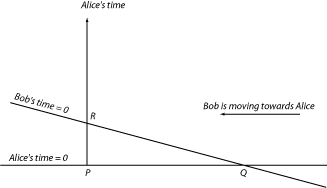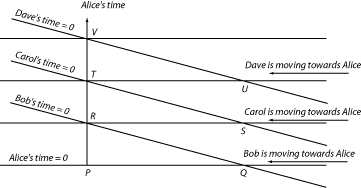The Block Universe
fmany of
‘Can a cube that does not last for any time at all, have a real
‘Clearly,’ the Time Traveller proceeded, ‘any real body must have extension in four directions: it must have Length, Breadth, Thickness, and–Duration. But through a natural infirmity of the flesh, which I will explain to you in a moment, we incline to overlook this fact. There are really four dimensions, three which we call the three planes of Space, and a fourth, Time. There is, however, a tendency to draw an unreal distinction between the former three dimensions and the latter, because it happens that our consciousness moves intermittently in one direction along the latter from the beginning to the end of our lives.’
– H. G. Well’s The Time Machine
This is still the best single explanation of the idea of the “block universe”, though Well’s Time Traveller does not use that term. As Julian Barbour puts it his The End of Time: “The objective world simply is, it does not happen. Only to the gaze of my consciousness, crawling upward along the life line of my body, does a section of this world come to life as a fleeting image in space which continuously changes in time.”
Perhaps the most famous evocation of the “fleeting image” side is Omar Khayyam’s:
The Moving Finger writes; and, having writ,
Moves on: nor all thy Piety nor Wit
Shall lure it back to cancel half a Line,
Nor all thy Tears wash out a Word of it.
This is an old debate, going back to the pre-Socratics, five centuries BCE, with Parmenides taking the block universe perspective “what is is uncreated and indestructible; for it is complete, immovable, and without end“, Heraclitus that of the fleeting moment “you cannot step twice into the same river“.
If time is a river – and this is certainly the most popular single metaphor for time – we have a choice between seeing the river as a whole, from the point of view of a geological surveyor, or of experiencing the river as a white water rafter, bend by bend, twist by twist. The surveyor’s is the perspective of the block universe, rafter’s of the fleeting moment.
The block universe perspective comes directly from special relativity. The problem is that simultaneity depends on the observer; what Alice thinks is simultaneous is different from what Bob thinks, if Bob is traveling at high velocity relative to Alice:

Alice at rest, Bob moving towards her. Or Bob at rest, Alice moving towards him.
Suppose we start with Alice thinking of herself as at rest, at point P. She will be quietly reading a book till time R – let’s say an hour later – when she will finish her chapter. From her point of view Bob is “now” at point Q, traveling rapidly towards her. But, according to special relativity, for Bob at Q, Q is happening “now” – and R is happening “now” as well! For Bob at Q, P is in the past. P and Q are simultaneous for Alice, but Q and R are simultaneous for Bob.
We can use this trick to construct a ladder of points going into the future:

Carol comes along an hour after Bob, Dave an hour after Carol
Suppose Carol comes along an hour after Bob, but at the same speed. Now R and S are at the same time for Alice, but S and T are at the same time for Carol.
And suppose Dave comes along an hour after Carol, again at the same speed. Now T and U are at the same time for Alice, but U and V are at the same time for Dave.
So, we have got a continuous chain of “now”‘s from P to Q to R to S to T to U to V to as far in the future as we care to do this. And we can do the same thing going into the past as well, if we assume that Bob, Carol, and Dave are moving to the right.
This is just an informal picture of the problem; there is a nice treatment of relativistic diagrams in Leo Sartori’s Understanding Relativity: A Simplified Approach to Einstein’s Theories. A much more sophisticated analysis of the problem is given in Vasselin Petkov’s “Is there an Alternative to the Block Universe View” (and see also his chapter “Relativity, Dimensionality, and Existence” in Relativity and the Dimensionality of the World (Fundamental Theories of Physics)
).
As all of physics is consistent with special relativity, it is difficult to find an escape from the block universe view, that in some sense everything is “now”.
Of course, there is the problem of the arrow of time. More accurately, arrows. It seems that time moves from past to future, with evidence from many disciplines: chemistry, radiation, particle decay, biology, evolution, economics, psychology,…
But if we look in detail at these arrows, they seem to all boil down to the thermodynamic arrow: entropy increases. Systems in states of low entropy evolve to be in states of higher entropy. If a room starts neat, with everything piled up in one corner, eventually things will be spread out all over. This is the celebrated second law of thermodynamics, that the entropy of an isolated system increases until the entropy is at a maximum.
And since the universe started at the Big Bang in a state of low entropy (everything piled up into one corner) the Big Bang becomes “the Mother of all Arrows of Time”. The directionality of time that we see is a side effect of the initial conditions of the universe, not something fundamental.
There has been a great deal of resistance to this conclusion. As Victor Stenger put it (in Timeless Reality : Symmetry, Simplicity, and Multiple Universes):
I feel that the possibility of time-reversal has been widely neglected for the wrong reason-a deep prejudice that time can only change from past to future. Evidence for this cannot be found in physics. The only justification for a belief in directed time is human experience, and human experience once said that the world was flat.
Huw Price discusses some of the arguments against in his Time’s Arrow and Archimedes’ Point: New Directions for the Physics of Time, warning:
We need to guard against the double standard fallacy–that of accepting arguments with respect to one temporal direction that we wouldn’t accept with respect to the other.
What is really the problem here is, I think, the psychological arrow, our intuitive understanding of time. When it comes to reasoning about time we are in roughly the position an intelligent fish might find itself in reasoning about water: the presence and flow of water is so integral to the fish’s existence and mentation that would be very difficult for the fish to “think outside the pond”, to visualize limits and alternatives to water.
In his Time and the Inner Future: A Temporal Approach to Psychiatric Disorders, Frederick Melges, a practicing psychiatrist, discusses at length the connections between problems with time perception (of duration, of sequence, of the relationship between past, present, and future) and various psychiatric disorders – schizophrenia, depression, mania, paranoia, and others. Melges quotes a paranoid physicist saying: “Time has stopped, there is no time… The past and the future have collapsed in to the present, and I can’t tell them apart.”
Given that this statement is also is essentially a description of the block universe view, it appears that there is only a single step from our mathematics to madness! Care will be required.
Returning to our river, let us suppose we are a river surveyor who also enjoys white water rafting. How do we relate the two activities? How do we go from the block universe view to the experience of time flowing, of birth, generation, and death?
Still, what if our river surveyor also likes white water rafting? How does he relate the block universe & the fleeting moment perspectives?
This is not an easy problem. The only paper I can recall having seen was a very technical one by Connes & Rovelli with the formidable title Von Neumann algebra automorphisms and time-thermodynamics relation in generally covariant quantum theories.
Further, if all the direction of time comes from entropy we would expect that there would be at least microscopic jitter in time (this is the subject of my paper Quantum Time).
And we might also ask if we might see switchbacks in time, the direction of local time completely flipping. One of my favorite papers, by L. S. Schulman, with the wonderful title Opposite Thermodynamic Arrows of Time, looks at what might happen in this case, arguing there is no essential contradiction.
So, on the one hand the arguments for the block universe are compelling, on the hand we haven’t seen any examples of even microscopic motions backwards in time.
Other Links to this Post
-
Time and Quantum Mechanics» Blog Archive » The Block Universe Verizon VZChina — December 6, 2009 @ 8:30 pm
-
Time and Quantum Mechanics » Why quantum time? — December 9, 2009 @ 10:40 am